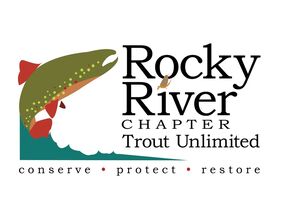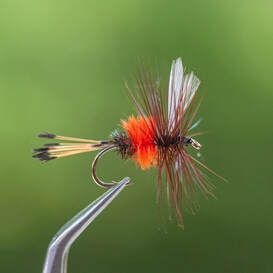Fly of the Month 04.21 - Coachman Variant
The origin of the variant fly pattern design is believed to be New England or possibly the Catskills. The specific origin is unknown. Variants are thought of primarily as a catskill fly pattern with an oversized, very bushy hackle and typically without the wings. These variant fly patterns provide a longer lasting and easy to see surface drift. The Cream, Dun and Gray Fox variants are all tied in this manner and are very productive when you need a cream, dun, or gray fox mayfly in rougher waters.
However, in the Southern Appalachians, ole’ timers tended to change a known fly pattern with a new twist and they called their new fly pattern a variant of the original fly pattern. There are at least two (2) unique Southern Appalachian variants, the Adams Variant and the Coachman Variant. The uniqueness comes from utilizing a brightly colored ostrich herl band for part of the body. The most well known example is the Adams Variant with the body changed to a yellow ostrich herl band between a fore and aft [Adams} hackle of brown and grizzly, mixed. Both variants are presented by Roger Lowe, Cashier, North Carolina in his book: Roger Lowe's Fly Pattern Guide to the Great Smoky Mountains.
Coachman Variant
The very well known Royal Coachman that originated in the UK was a favorite of the ole’ timers of the Southern Appalachians. This wet fly pattern was used to catch our native brookies long before dry fly patterns caught on in the late-1800s to early-1900s. It was pretty much replaced by the Royal Coachman Dry Fly and soon after by the even better floating, hair wing style Royal Wulff (or Wulff Royal as an ole’ timer would call it).
The Coachman Variant is tied by simply replacing the red floss band with an orange ostrich herl band on the Royal Coachman Dry Fly. Yes, ORANGE! The bright orange body makes it a good attractor in Southern Appalachian streams and especially remote headwaters. Orange is not as well utilized as yellow in our local waters. However, we have found that orange is an excellent change of color and highly visible when fishing for trout that do not seem to respond to fly patterns that they may have become accustomed to seeing.
These variants, using an ostrich herl banded body, appear to be a Southern Appalachian innovation! Typical of the creative Southern Appalachian fly tyers, when brightly colored, dyed ostrich herl was discovered or available, variations of other highly productive fly patterns soon emerged. Per Roger Lowe and by many accounts both the Adams Variant and the Coachman Variant are believed to have originated locally in the Southern Appalachians.
Recipe:
Coachman Variant
Hook: Standard Dry, Size 12, 14
Thread: Black 8/0 or equivalent
Tail: Golden Pheasant tippets
Wing: Cut wing white saddle feather or white rooster hackle tips, upright, divided
Body: Peacock herl, then center of body Orange ostrich herl
Hackle: Coachman brown rooster
Directions :
- Debarb and mount the hook in the vise and start the thread wraps at the eye. Make several wraps toward the bend to about the one third mark. Let the bobbin.
- Select two white saddle feathers that are about the same size. One from either side of the neck. The tips need to be stripped to the length of the hook shank. Tie in with the curve facing each other using the stripped tips to secure to the top of the hook shank. The wings should be about one third back from the eye. Make two or three x turns between the wings to divide and secure even more. Let the bobbin hang.
- Select six or eight Golden Pheasant tips being careful to keep the tips aligned when removing from the feather. It may help to cut away from the stem as opposed to pulling away. Tie these in on top of the hook shank immediately behind the wings after allowing the length past the hook bend to be about the same length as the hook shank. Cut away any waste and let the bobbin hang.
- Select a peacock herl and tie in at the hook bend. Make sure to tie in with the longer herl up. Advance the herl in tight and touching turns about five or six wraps. Cut the waste and let the bobbin hang.
- Select a stem of Orange Ostrich and tie in immediately in front of the peacock herl. Make five or six wraps of ostrich and secure making sure to allow for the rooster hackle. Trim the waste and let the bobbin hang.
- Select a rooster hackle sized for the hook and pull away barbs to expose and quarter inch or so of stem to tie in with. Tie in the rooster by holding the exposed stem at the base of the wings and use the thread to guide the stem for the first wrap immediately in front of the wings. Make two turns and then make two turns behind the wings. Advance the thread, trapping the stem along the shank to the ostrich. Return the thread to in front of the wings and let the bobbin hang.
- Make three or four tight and touching turns of rooster hackle trying not to bind any hackle as you go. Continue to wrap three or so turns in front of the wing leaving room for a small thread head. Trim the rooster waste. Make the thread head, finish with three whip finishes, cut the thread and apply head cement.
Fly of the Month 04.21
Directions:
Tom Adams and Alen Baker

